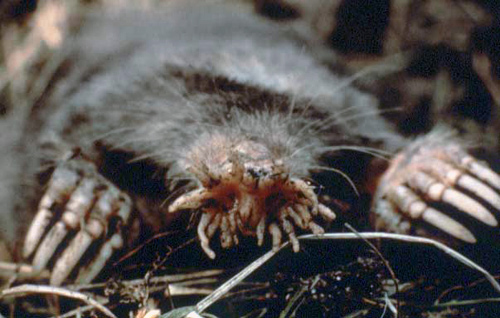Star-nosed moles are found throughout Connecticut. They have black fur, and wide talon-tipped forefeet designed for digging. The palms of these black and pinkish feet face outwards. They have a long hairy tail. The snout of a star-nosed mole gives them their name. It protudes, but instead of ending in a point it is tipped with 11 pairs of short, pink tentacles that splay out like a star. Star-nosed moles are smaller than the Eastern mole and weigh 1 to 2 1/2 oz.
The Star-nosed mole ranges through the most northern part of the northeast US and are found throughout New England. They also range up into southeastern Canada. They are active year-round. Unlike the Eastern Mole, Star-nosed Moles like wet areas and tunnel through mucky, swampy areas. It is unlikely that a Star-nosed Mole will be in your lawn. They dig systems of shallow underground tunnels as well as deeper passages. Nests will be built in a raised area that is less wet. Excavated soil will sometimes be pushed to the surface through a hole, creating a molehill. These moles are semi aquatic. their tunnels sometimes open directly into water. Star-nosed moles swim well. They dive for several seconds at a time, sometimes staying underwater over 30 seconds. In winter the moles hunt for food more in the water since the wet ground is apt to be frozen. They will swim under ice. If these moles come above ground to look for food it is almost always at night.
Star-nosed moles are insectivores. They eat earthworms as well as a variety of aquatic insects. When they eat, the nose tentacles are clumped up out of the way. It wouldn't do to nibble one's own nose.
These moles mate mate in February to March, and produce a spring litter, usually in April to May.
The most fascinating thing about a Star-nosed Mole is its star-nose! An underground-dweller, these moles have little use for eyesight. The tentacled nose is a sense organ used to locate prey. The nose tentacles are covered with very sensitive tactile hairs and organs of touch called Eimer's organs. The tentacles are mobile and the mole sweeps its nose through the water or soil while feeding. They can find prey using its sense of touch, and some research suggests the tentacles may also sense electrical impulses from the insects they eat.
Neat Fact
Star-nosed moles smell underwater by exhaling air bubbles onto objects and then re-inhaling them to smell the scents they have trapped.
